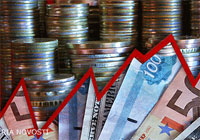NEWSLINK: The Illusion of a Rich Russia

[The Illusion of a Rich Russia – Moscow Times/Vedomosti – Dec. 3, 2012 – http://www.themoscowtimes.com/opinion/article/the-illusion-of-a-rich-russia/472315.html]
The Moscow Times provides an English-language version of a Vedomosti editorial about perceptions and realities of wealth and poverty in Russia, holding that “Amid all of the seemingly good news, however, Russia’s poverty problem is far from conquered.”
First Vedomosti recounts some of the Western perceptions of growing Russian affluence:
Foreigners may think Russia has overcome the problem of poverty. “Russians seem to live worry-free lives, especially in the big cities,” writes journalist Pierre Avril in a Nov. 13 article in Le Figaro. “While housewives in Europe battle depression, Russia seems unaffected by the crisis, and families buy up consumer goods at a prodigious pace.” Avril notes that Russians buy cars, luxury goods and food items as though they were unaffected by any economic problems at all.
The quantity of mobile phone numbers registered to every 100 people is 1 1/2 times higher in Russia than in France, the U.S. or Japan. The amount Russians spend on international tourism has grown so quickly that they now rank seventh in the world, pushing ahead of the Japanese. LVMH the world’s largest luxury retailer and producer of Moet & Chandon champagne, Hennessy cognac as well as clothing and accessories sold under the Fendi, Kenzo and Louis Vuitton brand names has shown growth in sales in Russia for years on end.
The number of Russians who live below the poverty line, as defined by the World Bank, is exceptionally small, according to the report “Farewell to Poverty” by Mikhail Dmitriyev, head of the Federal Center for Social Development, and Svetlana Misikhina, head of the National Economics Academy’s Center for Social Policy. Russia’s formerly impoverished population has now climbed above the benchmark of spending $2 per day (measured as the daily purchasing power parity) and has now become the “wealthy poor.” The nearly 12 percent of Russians who continue to live on $2 to $10 per day enjoy a higher standard of living than comparable segments of the population in China, India and Indonesia. What’s more, they are buying almost as much food and as many telephones, televisions and computers as people with even higher incomes. In addition, thanks to the Soviet legacy, Russians enjoy almost equal access to the country’s infrastructure.
But Vedomosti sounds the alarm over a debt-induced illusion of prosperity:
… the boom in consumption is not necessarily the result of greater incomes but of the rapid growth in borrowing. Russians are accumulating debt at an alarming rate. Individual borrowing is outpacing corporate borrowing by 300 percent. The number of loans that Russians have taken out this year is 40 percent higher than last year. Similar growth in the borrowing rate was last seen just before the 2008 crisis, when the rate of borrowing was climbing by 55.8 percent.
Moreover, real-world standard of living does not match the other indicators:
… if poverty were measured … by more qualitative indicators such as the quality of housing and health, the picture would not be as rosy as we have been led to believe.
Housing conditions are also an accurate indicator of Russians’ real standard of living. More than 61 percent of Russians have a very modest living space per person: 7 square meters to 30 square meters. Another 2.3 percent are even more tightly packed at home, according to the Higher School of Economics National Research University. Worse, the level of “housing poverty” has not changed appreciably in the last 20 years. In addition, considering that the price for 1 square meter of an apartment is now several times greater than the average Russian’s income, the only chance most people have for an improvement in living conditions is if a family member dies and leaves more room for the others.
What about health? … Russia is experiencing … 18 percent more illnesses registered than before. Taking into account the shrinking population, the real increase in illness is actually 20.4 percent. Taken separately, the illness rate among youth is up 150 percent.
Vedemosti is left to conclude that income inequality helps explain the statistics in the face of lingering real-world poverty:
Obviously, it is not the people with tuberculosis living in shoebox-sized apartments along with a handful of relatives who are snatching up Louis Vuitton handbags. Rapidly growing income inequality is a characteristic of modern Russia. True, the poorest Russians are not as bad off as those in India and China, but this country has a different cultural makeup and had already taken steps in the last century to eliminate the worst forms of poverty. Yet it remains a distant dream to eradicate widespread poverty.
Click here for full article: http://www.themoscowtimes.com/opinion/article/the-illusion-of-a-rich-russia/472315.html
